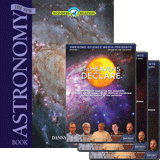What’s Up in 2019?
The year begins with a bang, for on the morning of January 1, the moon and Venus will be close together in the sky. Both rise about three hours before the sun. Look to the southeast before sunrise; Venus will be the bright star near the moon. If the sky is very clear, you ought to be able to see Venus throughout the morning. Note the location of Venus with respect to the crescent moon before sunrise. At least until noon you ought to be able to spot the crescent moon in the sky. If you remember the direction and distance of Venus from the moon, it will be easy to spot Venus in the daytime sky. It will help to stand in the shadow of a building to do this. You will notice that the distance between the two will change throughout the morning. This is the result of the moon’s orbital motion around the earth.
Due to the earth’s rotation, both the moon and Venus will move westward at the rate of 15 degrees per hour. However, the moon’s orbital motion will carry it a little more than a half-degree per hour eastward. Venus will move eastward too, but not nearly as fast as the moon will. The next two mornings will be interesting, because the moon will progressively get closer to the sun as its waning crescent thins. On the morning of January 3, the moon will be close to Jupiter, another bright star in the early morning sky.
There will be two other opportunities to see Venus and the moon close together in the morning sky in 2019. On the morning of January 31, the moon will be even closer to Venus than it was early in the month (in parts of the south Pacific and South America, the moon will pass in front of Venus that morning, an event we call an occultation). The moon will be close to Venus again on the morning of March 2. These mornings will offer an easy opportunity to see Venus in the daytime, provided that the sky is very clear. Just use the technique that I described above.
Total Lunar Eclipse
January has another delight: a long total lunar eclipse on the night of January 20–21. With the following day a holiday for many people, this may be a good time to watch this eclipse. The partial phase of the eclipse begins at 10:34 p.m. Totality begins at 11:41 p.m. and lasts until 12:44 a.m. The partial phase ends at 1:51 a.m. Though binoculars or a telescope at low magnification may be helpful, they aren’t necessary to enjoy a lunar eclipse. Being at the height of winter, if the sky is clear, the temperature will be very cold, so be sure to dress warmly. At Johnson Observatory here at the Creation Museum, we are planning an event to watch the eclipse that night (learn more here).
After the awesome show that it put on last summer and autumn, Mars begins the year rapidly pulling away from the earth. By summer it departs the evening sky and reappears in the morning sky in autumn. Mars will look its best through the telescope early in the year, but, quite frankly, it won’t be much of a view. The next good view of Mars will be in the autumn of 2020. Venus, too, is at its best for the year in January and rapidly pulls away from earth. As it does, Venus will shrink from being half-lit to nearly fully lit by summer. In summer, Venus will leave the evening sky and reappear in the morning sky in the autumn, but, being so far from us, it will not be an impressive sight through telescopes.
Saturn
Saturn begins the year at conjunction with sun, meaning that it is behind the sun, farther than it ever gets from us, and lost in the sun’s glare. Jupiter begins the year not much better, having been in conjunction with the sun around Thanksgiving in 2018. However, by the beginning of the year, Jupiter may be glimpsed in the southeast shortly before sunrise. As I mentioned before, the moon will appear close to Jupiter on the morning of January 3, making it easier to find Jupiter that morning. Another good opportunity to find Jupiter will be on the morning of January 30, when Jupiter and Venus again will appear close together in the sky. Other close pairings of the moon and Jupiter in the morning sky will be on January 30, February 27, and March 27. Jupiter reaches opposition on June 9, meaning that it is up all night on that date. It’s also the absolute best time to see Jupiter, though Jupiter will be good for viewing in the morning sky from February until opposition and in the evening sky near opposition until autumn. If you have a small telescope, try looking at Jupiter. You ought to see up to four of its satellites, or moons. However, if you want to see Jupiter well through a telescope, it is best to do so when it is high as possible in the sky. When it is low in the sky, atmospheric turbulence blurs the image.
Saturn reaches opposition on July 8. Saturn will be good viewing in the morning sky from March until opposition and in the evening sky from opposition until nearly the end of the year. To aid in finding Saturn, look in the morning sky: the moon will be close to Saturn on February 2, March 1, and March 29. As with Jupiter, Saturn is splendid view through a telescope. Even a small telescope will reveal its rings. But keep in mind, as with Jupiter, it is best to do this when Saturn is as high in the sky as possible.
Stargazer Nights
As usual, we have public Stargazer nights at Johnson Observatory at the Creation Museum. The dates for these shows are April 12, May 11, June 7, July 5, August 9, September 7, October 4, and November 2. If the skies are clear, we will show you the moon, any planets that are out, a double star, some star clusters, and some nebulae and galaxies. If the sky is cloudy, we have a wonderful indoor program in our planetarium. Why don’t you join us one of these evenings?
Recommended Resources

Answers in Genesis is an apologetics ministry, dedicated to helping Christians defend their faith and proclaim the good news of Jesus Christ.
- Customer Service 800.778.3390
- © 2024 Answers in Genesis





